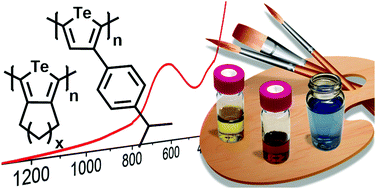Rapid access to (cycloalkyl)tellurophene oligomer mixtures and the first poly(3-aryltellurophene)†
Abstract
Polytellurophenes represent an emerging class of π-conjugated polymers that possess important characteristics for flexible electronics, such as narrow HOMO–LUMO gaps (Eg) and charge mobilities that can be orders of magnitude larger than their ubiquitous polythiophene counterparts. Herein we use the reactivity of pinacolboronate (BPin) groups attached to tellurophene scaffolds to directly prepare new 2,5-diiodinated monomers, which are then polymerized to afford new low Eg oligomers and polymers. Specifically, mixtures of (cycloalkyl)tellurophene oligomers (of 5 to 12 repeat units) with ring-fused 5- and 6-membered cyclic side chains were prepared via Yamamoto coupling, with a dramatic narrowing of band gap noted when less bulky 5-membered cycloalkyl side groups were present, due to enhanced tellurophene ring coplanarity. Grignard metathesis (GRIM) was also used to gain access to the first poly(3-aryltellurophene) with 94% regioregularity, along with a low Eg of 1.3 eV and an onset of light absorption at ca. 1000 nm.



 Please wait while we load your content...
Please wait while we load your content...